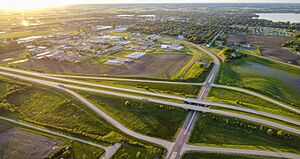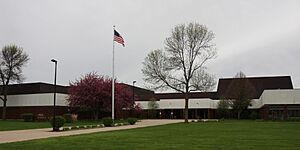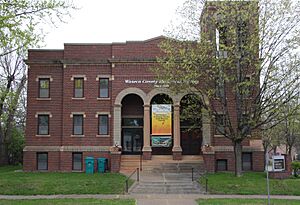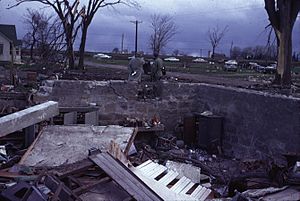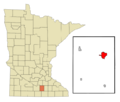Waseca, Minnesota facts for kids
Quick facts for kids
Waseca
|
|
|---|---|
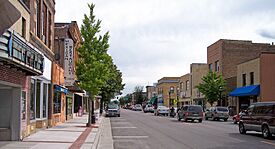
State Street in downtown Waseca in 2007
|
|
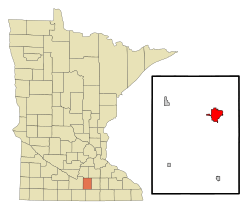
|
|
| Country | United States |
| State | Minnesota |
| County | Waseca |
| Platted | July 1867 |
| Incorporated as a village | March 2, 1868 |
| Incorporated as a city | February 23, 1881 |
| Government | |
| • Type | Mayor – Council |
| Area | |
| • Total | 5.47 sq mi (14.17 km2) |
| • Land | 4.29 sq mi (11.11 km2) |
| • Water | 1.18 sq mi (3.06 km2) |
| Elevation | 1,125 ft (343 m) |
| Population
(2020)
|
|
| • Total | 9,229 |
| • Estimate
(2022)
|
9,150 |
| • Density | 2,150.78/sq mi (830.42/km2) |
| Time zone | UTC−6 (Central (CST)) |
| • Summer (DST) | UTC−5 (CDT) |
| ZIP Code |
56093
|
| Area code(s) | 507 |
| FIPS code | 27-68296 |
| GNIS feature ID | 2397203 |
| Sales tax | 7.375% |
Waseca (say it: wuh-SEE-kuh) is a city in Minnesota, United States. It's the main city, or county seat, of Waseca County. In 2020, about 9,229 people lived here.
Contents
Geography and Climate
Waseca is located in the southern part of Minnesota. The city covers about 5.19 square miles (13.44 square kilometers). Most of this area is land, but about 1.19 square miles (3.08 square kilometers) is water.
Waseca's Weather
Waseca has a climate with four distinct seasons. Summers are warm, and winters are cold and snowy. The city experiences a good amount of rain, especially in the warmer months.
| Climate data for Waseca, Minnesota (Southern Research and Outreach Center) (1991–2020 normals, extremes 1914–present) | |||||||||||||
|---|---|---|---|---|---|---|---|---|---|---|---|---|---|
| Month | Jan | Feb | Mar | Apr | May | Jun | Jul | Aug | Sep | Oct | Nov | Dec | Year |
| Record high °F (°C) | 62 (17) |
69 (21) |
81 (27) |
92 (33) |
106 (41) |
105 (41) |
106 (41) |
103 (39) |
100 (38) |
93 (34) |
80 (27) |
68 (20) |
106 (41) |
| Mean daily maximum °F (°C) | 21.7 (−5.7) |
26.4 (−3.1) |
39.1 (3.9) |
55.2 (12.9) |
68.1 (20.1) |
78.3 (25.7) |
81.3 (27.4) |
79.1 (26.2) |
72.9 (22.7) |
58.7 (14.8) |
41.4 (5.2) |
27.5 (−2.5) |
54.1 (12.3) |
| Daily mean °F (°C) | 13.2 (−10.4) |
17.5 (−8.1) |
30.7 (−0.7) |
45.1 (7.3) |
57.9 (14.4) |
68.4 (20.2) |
71.4 (21.9) |
69.0 (20.6) |
61.6 (16.4) |
47.8 (8.8) |
32.9 (0.5) |
19.8 (−6.8) |
44.6 (7.0) |
| Mean daily minimum °F (°C) | 4.8 (−15.1) |
8.7 (−12.9) |
22.3 (−5.4) |
34.9 (1.6) |
47.8 (8.8) |
58.6 (14.8) |
61.4 (16.3) |
59.0 (15.0) |
50.4 (10.2) |
36.9 (2.7) |
24.4 (−4.2) |
12.1 (−11.1) |
35.1 (1.7) |
| Record low °F (°C) | −37 (−38) |
−35 (−37) |
−29 (−34) |
−3 (−19) |
19 (−7) |
31 (−1) |
39 (4) |
34 (1) |
20 (−7) |
−1 (−18) |
−21 (−29) |
−35 (−37) |
−37 (−38) |
| Average precipitation inches (mm) | 1.27 (32) |
1.20 (30) |
2.25 (57) |
3.30 (84) |
4.47 (114) |
5.38 (137) |
4.93 (125) |
4.82 (122) |
4.12 (105) |
2.77 (70) |
1.89 (48) |
1.50 (38) |
37.90 (963) |
| Average snowfall inches (cm) | 10.7 (27) |
10.8 (27) |
9.0 (23) |
3.0 (7.6) |
0.4 (1.0) |
0.0 (0.0) |
0.0 (0.0) |
0.0 (0.0) |
0.0 (0.0) |
0.7 (1.8) |
5.8 (15) |
11.9 (30) |
52.3 (133) |
| Average precipitation days (≥ 0.01 in) | 8.8 | 7.7 | 9.7 | 12.0 | 14.1 | 13.3 | 10.9 | 10.9 | 9.7 | 9.9 | 8.1 | 9.1 | 124.2 |
| Average snowy days (≥ 0.1 in) | 7.9 | 6.7 | 4.8 | 1.6 | 0.1 | 0.0 | 0.0 | 0.0 | 0.0 | 0.6 | 3.4 | 7.6 | 32.7 |
| Source: NOAA | |||||||||||||
People of Waseca
| Historical population | |||
|---|---|---|---|
| Census | Pop. | %± | |
| 1870 | 551 | — | |
| 1880 | 1,708 | 210.0% | |
| 1890 | 2,482 | 45.3% | |
| 1900 | 3,103 | 25.0% | |
| 1910 | 3,054 | −1.6% | |
| 1920 | 3,908 | 28.0% | |
| 1930 | 3,815 | −2.4% | |
| 1940 | 4,270 | 11.9% | |
| 1950 | 4,927 | 15.4% | |
| 1960 | 5,898 | 19.7% | |
| 1970 | 6,789 | 15.1% | |
| 1980 | 8,219 | 21.1% | |
| 1990 | 8,385 | 2.0% | |
| 2000 | 8,493 | 1.3% | |
| 2010 | 9,410 | 10.8% | |
| 2020 | 9,229 | −1.9% | |
| 2022 (est.) | 9,150 | −2.8% | |
| U.S. Decennial Census 2020 Census |
|||
In 2010, Waseca had 9,410 people living in 3,504 households. About 30.9% of these households had children under 18. The average household had 2.33 people.
The city's population was quite diverse. About 89% of residents were White, 3.7% were African American, and 1.5% were Native American. About 9% of the population identified as Hispanic or Latino.
The average age in Waseca was 36.5 years old. About 22.5% of residents were under 18, and 13.4% were 65 or older.
Getting Around Waseca
Waseca has bus service provided by Southern Minnesota Area Rural Transit (SMART). You can catch a bus on a set route or call for a ride.
Two main roads go through Waseca. U.S. Highway 14 is a freeway that goes east and west just south of the city. Minnesota Highway 13 runs north and south through the city as State Street.
Schools in Waseca
Waseca has several schools, and their school colors are blue and gold. Their mascot is the bluejay!
- Hartley Elementary School: This school is for younger students, from kindergarten to 3rd grade.
- Waseca Intermediate School (WIS): This school teaches students in 4th, 5th, and 6th grades. It used to be called Central Immediate School.
- Waseca Junior and Senior High School (WJSHS): This school is for students in grades 7 through 12. Before 2012, it was known as Waseca High School and only served grades 9-12.
- Waseca Alternative High School (WALC): Also called the Alternative Learning Center (ALC), this program helps students from junior high age to adults learn in a different way.
- Sacred Heart School: This is a private Catholic elementary school for kindergarten through fourth grade. It also has a Montessori preschool.
- Other Preschools: Hansel & Gretel is another preschool at Faith United Methodist Church. Waseca County Head Start also offers preschool programs.
- TEAM Academy: This is a charter school for students from kindergarten to 6th grade.
Waseca was once home to the University of Minnesota Waseca, a two-year college that closed in 1992. Today, much of its old campus is used as the Southern Research and Outreach Center. This center has farmland for research, a community garden, and a special tree collection called the Hodgson Memorial Arboretum.
Waseca's Economy
Waseca has some important businesses that help the city's economy.
- ConAgra Brands: This company has a plant in Waseca that packs frozen vegetables like peas and corn.
- Federal Correctional Institution, Waseca: This is a federal prison for female inmates. It's located in buildings that used to be part of the University of Minnesota Waseca campus.
- Waseca Medical Center: This medical center is part of the Mayo Clinic Health System, providing healthcare to the community.
Fun and Recreation
Waseca offers many ways to have fun and enjoy the outdoors!
- Waterpark: A waterpark opened in Waseca in June 2007, perfect for cooling off in the summer.
- Bike Path: In 2014, an eight-foot-wide asphalt bike path was finished around Clear Lake, great for biking or walking.
- Parks and Lakes: Waseca has many parks and lakes for everyone to enjoy. Some popular spots include:
* Clear Lake * Loon Lake * Maplewood Park * Clear Lake Park * Loon Lake Park * Courthouse Park * Blowers Park
Waseca's History
Waseca was officially planned out in July 1867. It grew quickly because a railroad stop was built there. Within a year, it became a major place for shipping wheat. The city soon had 129 buildings and 700 people.
The name "Waseca" comes from the Dakota language. It means "rich in provisions," which makes sense because it was a center for farming. In the mid-1900s, three big companies started in Waseca: Brown Printing, EF Johnson Technologies Inc., and Herter's Outdoor Gear. These companies helped Waseca have a strong economy.
University and Research
In 1912, the University of Minnesota bought land in Waseca. They started an experimental farm called Southeast Station. Here, they studied things like corn and how to breed pigs and cattle. In 1953, the university opened the Southern School of Agriculture. This was a boarding school for farming students. In 1971, it became the University of Minnesota Waseca, a two-year technical college. Almost 20,000 students attended before it closed in 1992.
Local Businesses with a Big Impact
- E.F. Johnson Co.: Founded in 1923 by Edgar F. Johnson and his wife, Ethel, this company started by selling radio parts. It grew to be a major supplier during World War II. The Johnsons also helped create the Waseca County Historical Society.
- Herter's: Started by George Herter in 1937, this company became famous for its mail-order outdoor gear. Herter's catalogs were very popular and helped Brown Printing grow.
- Brown Printing: This company started in 1949 and became very successful. It printed many catalogs, including Herter's.
A post office has been in Waseca since 1867. Waseca officially became a city in 1881.
Waseca During World War II
During World War II, the E.F. Johnson Company plant worked 24 hours a day to help with war production. Waseca was one of the first cities to use its own money to buy war bonds, showing its support for the war effort.
On April 30, 1967, a strong tornado hit Waseca. It caused a lot of damage to the city.
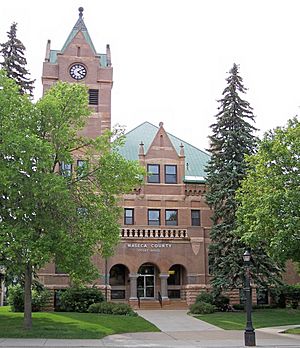
Waseca has six buildings that are listed on the National Register of Historic Places. These are important historical sites that are protected.
Notable People from Waseca
Many interesting people have connections to Waseca:
- Reverend E.H. Alden: A person made famous in Laura Ingalls Wilder's Little House on the Prairie books.
- George Herter: The founder of Herter's outdoor goods business and an author.
- Dave Kunst: The first person to walk all the way around the world! His amazing journey started and ended in Waseca between 1970 and 1974.
- Leroy Shield: A composer, conductor, and arranger for films, including those featuring the Little Rascals and Laurel & Hardy. He was born in Waseca.
- Tim Penny: A former U.S. Representative.
Images for kids
See also
 In Spanish: Waseca (Minnesota) para niños
In Spanish: Waseca (Minnesota) para niños


